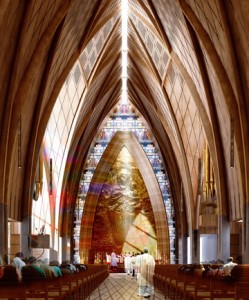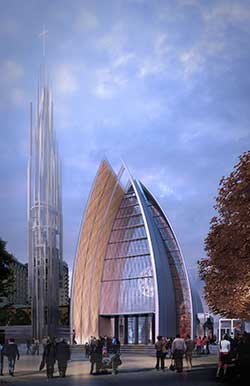The area near the city of Christchurch New Zealand suffered a 7.1 earthquake on 4 SEP 2010 at 4:10 am. There was widespread damage, but few fatalities, likely because not many were in the streets at that hour. Again on 12 FEB 2011 at 12:51 pm the area around Christchurch experienced a 6.3 earthquake which added more destruction to the previously damaged city and this time killed 185 and injured between 1500 and 2000 people, some critically. Both quakes also were followed by numerous aftershocks. The numbers who fled Christchurch following the catastrophe were sufficient to drop Christchurch from the 2nd most populated metropolitan area in New Zealand to 3rd. As a result of the quakes, buildings which weren’t outright destroyed by the shaking were damaged to the point they were structurally weakened and had to be torn down, One iconic building that suffered damage was Christ Church Cathedral, the cathedral church of the Diocese of Christchurch, which sat on Cathedral Square in the heart of the city.
The Revd Bosco Peters has covered the events in Christchurch in a number of stories at his blog Liturgy – spirituality that works for people. Construction of the cathedral was begun in 1864. It was consecrated 17 years later. Since it’s origin the building has suffered damage in a total of 5 earthquakes during its lifetime, plus one that occurred soon after the original construction began. Because of the 2011 quake, the building has suffered significant damage. Some of what didn’t fall down on its own, has been taken down for safety precautions. From photographs it can be seen that the tower has been removed, as well as the entire front entrance to the building, including the rose window. The diocesan leadership, under the helm of the Rt Revd Victoria Mathews, was open to exploring a number of options available to the diocese for building a new cathedral. Subsequently the diocese explored three options;
- Restoration – completely razing the original structure and building an exact copy, but utilizing modern earthquake resisting techniques. The most costly option. Would take the longest time to accomplish.
- Traditional – razing the original structure and building a lighter wooden structure similar to the original building in its footprint. This took into consideration that the architect of the cathedral had originally intended to build a wooden structure. Second most costly option. Wouldn’t take as long to build as a restoration.
- Contemporary – razing the original structure and building in its footprint a completely new modern building which would draw upon light construction materials and utilize the most up-to-date earthquake resisting technology. The interior would be a blank canvass for 21st Century needs. The least costly option. The fastest to build.

The diocese and the entity that owns the building, the Church Property Trust (CPT), chose the 3rd option, to build a contemporary building. One local secular organization has been dead set against anything that was not a complete restoration of the original 19th Century structure. The Great Christchurch Building Trust (GCBT), unhappy with the diocese’s decision to build a new, contemporary building, took the diocese and the Church Property Trust to court to prevent their plans from proceeding. Now five years down the road from the quake which caused the major damage, the building sits in disrepair as housing for pigeons. The fact that the cathedral hasn’t begun its journey to being rebuilt, has adversely affected the repair and revitalization of the central district in Christchurch.
Subsequently, the Government (local? national?) appointed a local attorney, Miriam Dean QC, to mediate between the two entities, Dio Christchurch/CPT and GCBT. 23 DEC, when most folks in New Zealand were expecting the announcement of a decision, instead they got a commitment by Dio Christchurch/CPT to take another look at the full restoration option. However, Dio Christchurch/CPT have not committed to a full restoration. The possibility exists that in the end they will decide to build a new, contemporary structure to meet the needs of the diocese.
The engineers for the two sides have agreed on cost and construction estimates for the restoration vs contemporary options. This information was provided by the mediators report;
- Engineers for CPT and GCBT agreed the church could be reinstated through a mix of repair, restoration, reconstruction and seismic strengthening.
- Reinstatement would likely take until the end of 2022 and cost $105 million.
- Replacement could be completed by the end of 2019, costing $63m to $66m.
- The cathedral could be reinstated “to the extent that, for most people, it would be indistinguishable from the pre-earthquake building”.
I recall from reading numerous stories by Father Bosco, as well as his links to the coverage by the secular press, regarding the rebuilding of the City of Christchurch, especially it central core, that planners and designers viewed the destruction as an opportunity for Christchurch to begin again. They wanted to commit to building a more centrally planned city center utilizing earthquake resistant and green technologies. To build a city for Christchurch’s future that met its needs today and also tomorrow. Sadly, some of those same folks don’t seem open to affording the Anglicans of Christchurch that same freedom in building the new Christ Church Cathedral!
The images were lifted from Father Bosco’s blog.
The story was gathered from various Wikipedia articles, stories posted at Liturgy.co.nz, and a story from Anglican Taonga.

